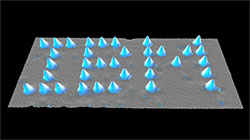
Atom-moving Marks 20 Years
Twenty years ago today, IBM Fellow Don Eigler became the first person in history to move and control an individual atom, an ability that heralded the age of nanotechnology.
 Eigler built his scanning tunneling microscope (STM) in order to visualize and experiment with individual molecules and atoms. As he experimented, he discovered that it was possible to slide individual atoms across a surface using the tip of his STM. To demonstrate both the atomic precision and reproducibility he achieved, on Nov. 11, 1989, he wrote the letters "IBM" with 35 xenon atoms, each positioned with atomic-scale precision. (Watch Eigler discuss his achievement here)
Eigler built his scanning tunneling microscope (STM) in order to visualize and experiment with individual molecules and atoms. As he experimented, he discovered that it was possible to slide individual atoms across a surface using the tip of his STM. To demonstrate both the atomic precision and reproducibility he achieved, on Nov. 11, 1989, he wrote the letters "IBM" with 35 xenon atoms, each positioned with atomic-scale precision. (Watch Eigler discuss his achievement here)
“Don Eigler’s accomplishment remains, to this day, one of the most important breakthroughs in nanoscience and technology,” said T.C, Chen, IBM Fellow and vice president, Science & Technology, IBM Research. “At the time, the implications of this achievement were so far-reaching they almost seemed like science fiction. But now, twenty years later, it’s clear that this was a defining moment that has spawned the kind of research that will eventually bring us beyond CMOS and Moore’s Law, to advance computing to handle the massive volumes of data in the world while using less energy resources. ”
Understanding the properties, movement and interaction of various materials at the nanoscale is essential for one day building smaller, faster and more energy-efficient processors and memory devices. This understanding could also eventually enable a whole new level of personalized health care and targeted treatments and therapies.
The ability to understand and manipulate atoms is already leading to new kinds of fabrics and products, from water-resistant raincoats to sunscreen that stays put even after swimming.

On Sept. 28, 1989, IBM Fellow Don Eigler became the first person in history to move and control an individual atom. Shortly thereafter, on Nov. 11, Eigler and his team used a custom-built STM microscope to spell out the letters IBM with 35 xenon atoms. This unprecedented ability to manipulate individual atoms signaled a quantum leap forward in in nanoscience experimentation and heralded the age of nanotechnology. (Photos: IBM)
Because of Eigler’s seminal work, scientists continue making breakthroughs that continue driving the field of nanotechnology, the exploration of building structures and devices out of ultratiny components as small as a few atoms or molecules. Such devices might be used as future computer chips, storage devices, biosensors, and things nobody has even imagined.
Two IBM scientists in Switzerland won the 1986 Nobel Prize in physics for their early 1980s invention of the STM. Since then, IBM researchers have pioneered the use of STMs for positioning atoms into precisely designed structures that reveal fundamental atomic-scale properties and may have potential uses in information storage, transmission and processing.
For more information, visit www.ibm.com/research
Published: September 2009